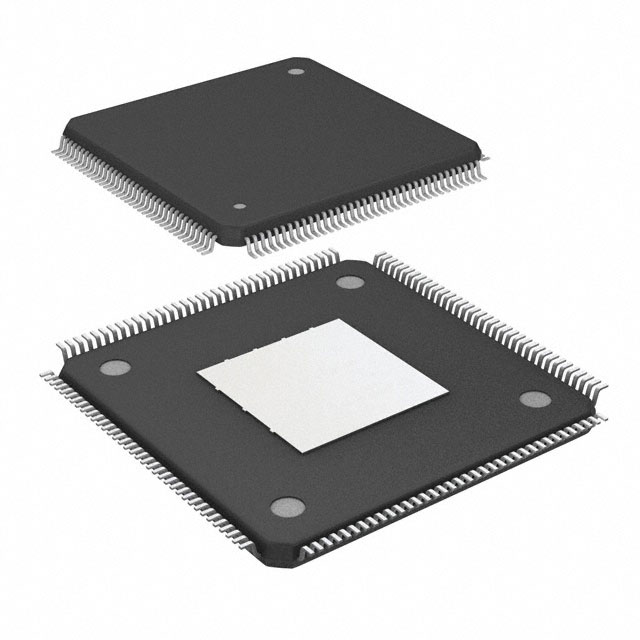Xem thông số kỹ thuật để biết chi tiết sản phẩm.

EP4CE6E22C6N
Product Overview
- Category: Programmable Logic Device (PLD)
- Use: EP4CE6E22C6N is a PLD used for digital logic design and implementation.
- Characteristics: It offers high performance, low power consumption, and flexibility in designing complex digital circuits.
- Package: The EP4CE6E22C6N comes in a compact package suitable for surface mount technology.
- Essence: It provides a cost-effective solution for implementing custom digital logic designs.
- Packaging/Quantity: The EP4CE6E22C6N is typically packaged in reels or trays, with quantities varying based on customer requirements.
Specifications
- Logic Elements: 6272
- Embedded Memory: 414 Kbits
- Maximum User I/Os: 179
- Maximum User I/O Pins: 144
- Operating Voltage: 1.15V - 1.25V
- Speed Grade: 6
- Clock Networks: 8
- PLLs: 2
- Total RAM Bits: 414720 bits
- Total DSP Blocks: 16
Detailed Pin Configuration
The EP4CE6E22C6N has a total of 144 user I/O pins, which can be configured as inputs or outputs based on the design requirements. These pins are distributed across different banks, each having its own voltage supply and I/O standards. The pin configuration allows for easy interfacing with external devices and other components of the digital system.
Functional Features
- High-performance architecture: The EP4CE6E22C6N offers fast processing speeds and efficient resource utilization, making it suitable for demanding applications.
- Low power consumption: It incorporates power-saving features to minimize energy consumption, making it ideal for battery-powered devices.
- Flexible I/O standards: The device supports various I/O standards, allowing for easy integration with different communication protocols and interfaces.
- Embedded memory: The EP4CE6E22C6N includes a significant amount of embedded memory, enabling the implementation of complex algorithms and data storage.
Advantages and Disadvantages
Advantages: - High performance and flexibility - Low power consumption - Cost-effective solution for custom logic designs - Extensive I/O options - Ample embedded memory
Disadvantages: - Limited capacity compared to larger PLDs - Requires expertise in digital logic design and programming
Working Principles
The EP4CE6E22C6N is based on a programmable logic architecture that allows users to define the desired functionality by configuring the internal logic elements and interconnections. The device utilizes look-up tables (LUTs) to implement Boolean functions and flip-flops for sequential logic. The configuration is stored in non-volatile memory, ensuring that the programmed design remains intact even after power cycles.
Detailed Application Field Plans
The EP4CE6E22C6N finds applications in various fields, including:
- Embedded Systems: It can be used to implement control and communication modules in embedded systems, such as industrial automation and IoT devices.
- Digital Signal Processing: The device's DSP blocks enable efficient implementation of signal processing algorithms, making it suitable for audio and video processing applications.
- Communication Systems: It can be utilized in the development of communication systems, including wireless transceivers and network switches.
- Consumer Electronics: The EP4CE6E22C6N can be integrated into consumer electronics products like gaming consoles, smart TVs, and home automation systems.
Detailed and Complete Alternative Models
- EP4CE10E22C8N: This model offers higher logic capacity and more I/O pins, suitable for larger-scale designs.
- EP4CE15E22C8N: Similar to the previous model, but with even higher logic capacity and additional features like more embedded memory.
- EP4CE30E22C8N: This model provides further increased logic capacity and enhanced performance for demanding applications.
These alternative models offer a range of options based on the specific requirements of the design, allowing users to choose the most suitable PLD for their project.
Word count: 540 words
Liệt kê 10 câu hỏi và câu trả lời thường gặp liên quan đến ứng dụng EP4CE6E22C6N trong giải pháp kỹ thuật
Sure! Here are 10 common questions and answers related to the application of EP4CE6E22C6N in technical solutions:
Q: What is EP4CE6E22C6N? A: EP4CE6E22C6N is a field-programmable gate array (FPGA) chip manufactured by Intel (formerly Altera). It offers programmable logic, memory, and digital signal processing capabilities.
Q: What are the key features of EP4CE6E22C6N? A: Some key features include 6272 logic elements, 270Kbits of embedded memory, 126 user I/O pins, and support for various communication protocols like SPI, I2C, UART, etc.
Q: How can EP4CE6E22C6N be used in technical solutions? A: EP4CE6E22C6N can be used in a wide range of applications such as industrial automation, robotics, telecommunications, medical devices, image processing, and many more.
Q: Can EP4CE6E22C6N be programmed using a high-level language? A: Yes, EP4CE6E22C6N can be programmed using high-level languages like VHDL or Verilog, which provide a hardware description language (HDL) to describe the desired functionality.
Q: Is it possible to interface EP4CE6E22C6N with other components or microcontrollers? A: Yes, EP4CE6E22C6N supports various communication interfaces like SPI, I2C, UART, etc., allowing easy integration with other components or microcontrollers.
Q: Can EP4CE6E22C6N handle real-time processing tasks? A: Yes, EP4CE6E22C6N can handle real-time processing tasks efficiently due to its high-speed logic elements and dedicated digital signal processing (DSP) blocks.
Q: What are the power requirements for EP4CE6E22C6N? A: EP4CE6E22C6N typically operates at a voltage range of 1.15V to 3.465V, with power consumption depending on the design complexity and operating frequency.
Q: Can EP4CE6E22C6N be reprogrammed multiple times? A: Yes, EP4CE6E22C6N is a reprogrammable FPGA, allowing you to modify and reconfigure the design multiple times as per your requirements.
Q: Are there any development tools available for programming EP4CE6E22C6N? A: Yes, Intel provides Quartus Prime software, which includes a suite of development tools for designing, simulating, and programming EP4CE6E22C6N.
Q: Where can I find more resources and documentation for EP4CE6E22C6N? A: You can find detailed documentation, datasheets, reference designs, and application notes on Intel's website or community forums dedicated to FPGA development.

